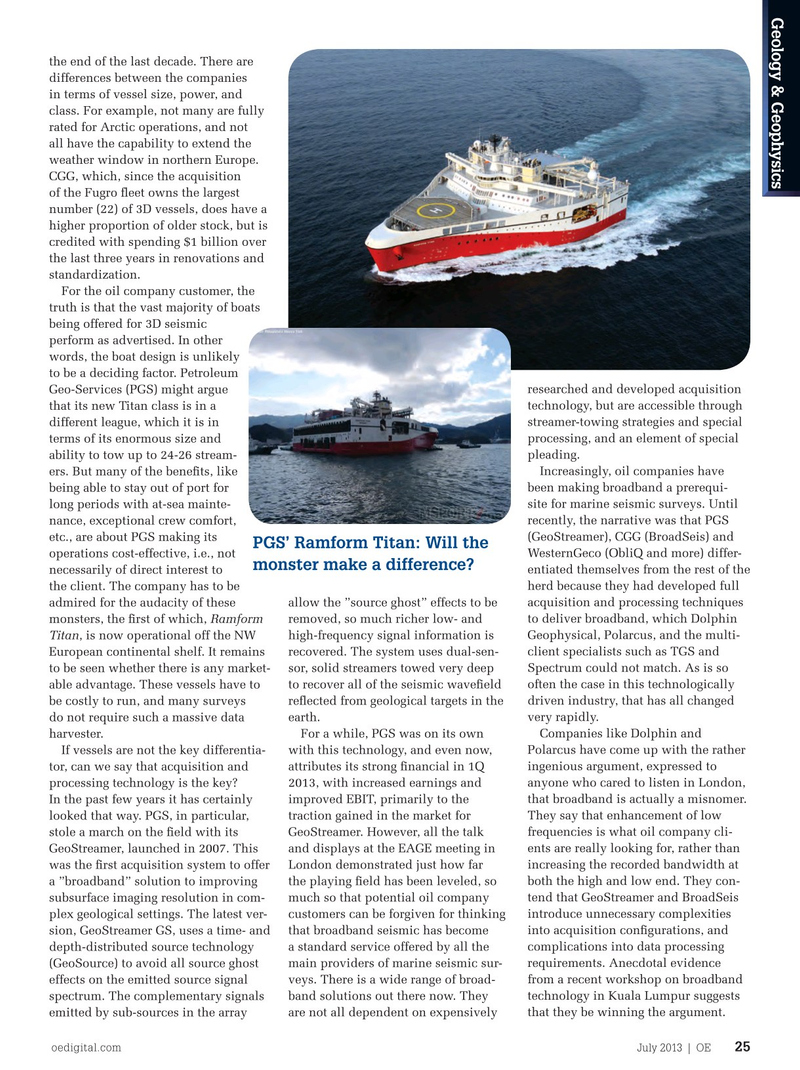
Page 23: of Offshore Engineer Magazine (Jul/Aug 2013)
Read this page in Pdf, Flash or Html5 edition of Jul/Aug 2013 Offshore Engineer Magazine
Geology & Geophysics
Eyebrow the end of the last decade. There are differences between the companies in terms of vessel size, power, and class. For example, not many are fully rated for Arctic operations, and not all have the capability to extend the weather window in northern Europe.
CGG, which, since the acquisition of the Fugro feet owns the largest number (22) of 3D vessels, does have a higher proportion of older stock, but is credited with spending $1 billion over the last three years in renovations and standardization.
For the oil company customer, the truth is that the vast majority of boats being offered for 3D seismic perform as advertised. In other words, the boat design is unlikely to be a deciding factor. Petroleum
Geo-Services (PGS) might argue researched and developed acquisition that its new Titan class is in a technology, but are accessible through different league, which it is in streamer-towing strategies and special terms of its enormous size and processing, and an element of special ability to tow up to 24-26 stream- pleading. ers. But many of the benefts, like Increasingly, oil companies have being able to stay out of port for been making broadband a prerequi- long periods with at-sea mainte- site for marine seismic surveys. Until nance, exceptional crew comfort, recently, the narrative was that PGS etc., are about PGS making its (GeoStreamer), CGG (BroadSeis) and
PGS’ Ramform Titan: Will the operations cost-effective, i.e., not WesternGeco (ObliQ and more) differ- monster make a difference?
necessarily of direct interest to entiated themselves from the rest of the the client. The company has to be herd because they had developed full admired for the audacity of these allow the ”source ghost” effects to be acquisition and processing techniques monsters, the frst of which, Ramform removed, so much richer low- and to deliver broadband, which Dolphin
Titan, is now operational off the NW high-frequency signal information is Geophysical, Polarcus, and the multi-
European continental shelf. It remains recovered. The system uses dual-sen- client specialists such as TGS and to be seen whether there is any market- sor, solid streamers towed very deep Spectrum could not match. As is so able advantage. These vessels have to to recover all of the seismic wavefeld often the case in this technologically be costly to run, and many surveys refected from geological targets in the driven industry, that has all changed do not require such a massive data earth. very rapidly.
harvester. For a while, PGS was on its own Companies like Dolphin and
If vessels are not the key differentia- with this technology, and even now, Polarcus have come up with the rather tor, can we say that acquisition and attributes its strong fnancial in 1Q ingenious argument, expressed to processing technology is the key? 2013, with increased earnings and anyone who cared to listen in London,
In the past few years it has certainly improved EBIT, primarily to the that broadband is actually a misnomer. looked that way. PGS, in particular, traction gained in the market for They say that enhancement of low stole a march on the feld with its GeoStreamer. However, all the talk frequencies is what oil company cli-
GeoStreamer, launched in 2007. This and displays at the EAGE meeting in ents are really looking for, rather than was the frst acquisition system to offer London demonstrated just how far increasing the recorded bandwidth at a ”broadband” solution to improving the playing feld has been leveled, so both the high and low end. They con- subsurface imaging resolution in com- much so that potential oil company tend that GeoStreamer and BroadSeis plex geological settings. The latest ver- customers can be forgiven for thinking introduce unnecessary complexities sion, GeoStreamer GS, uses a time- and that broadband seismic has become into acquisition confgurations, and depth-distributed source technology a standard service offered by all the complications into data processing (GeoSource) to avoid all source ghost main providers of marine seismic sur- requirements. Anecdotal evidence effects on the emitted source signal veys. There is a wide range of broad- from a recent workshop on broadband spectrum. The complementary signals band solutions out there now. They technology in Kuala Lumpur suggests emitted by sub-sources in the array are not all dependent on expensively that they be winning the argument. oedigital.com July 2013 | OE 25 oe0713_G_G_notebook.indd 25 6/24/13 1:49 AM

 22
22

 24
24